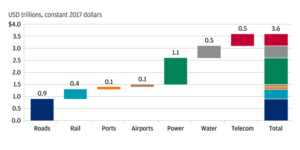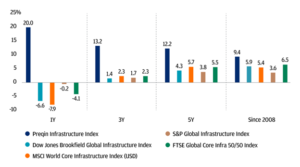In crisis there is opportunity.
The infrastructure of modern society – utilities, telecom systems, energy systems, highways, and other components – is essential for global economic development, unavoidable, demanded by many, pose insurmountable obstacles, and is poised at the edge of transformational change.
They Want What We Have
Emerging economies need a range of basic infrastructure and services, especially in fast-growing cities – now becoming megalopolises. They will not wait for a “green future” to develop. Carbon footprint reduction is not a priority and is independent of emerging economies’ government policy.
On top of this, developed economies are not done building and increasing energy usage. Aging essential infrastructure, such as bridges and water utilities, needs upgrades. The move toward a greener global energy future, and a more advanced and digitally connected society, needs to be built.
The capital that will be needed far surpasses any government’s capacity. Energy is one simple and obvious example. It is reasonable to predict that by 2050, cities will add, on average, over two million miles of power lines and lay more than four million miles of water and sewage pipes. Since these expenditures are beyond the limits of any government, not just emerging economies, private capital is the only solution.
Sustainability of Sustainability
This is just one example of why there will be a record pace of growth in the private infrastructure market. On top of that, it adds a commercial discipline and economic dimension to any “green” initiative. If it is not cost-effective or profitable, it will not happen. Governments simply do not have the capital to keep subsidizing costly attempts to address the carbon footprint of essential infrastructure development.
If infrastructure has the potential to deliver strong investment returns, then this transition will happen. One reason is that infrastructure isn’t optional, it’s essential. It must be done in economic terms not wishful thinking for a better outcome even if the cost is far too high.
Infrastructure expenditure and use are not optional. All infrastructure is needed all the time, whether the economy is thriving or not. Moreover, returns don’t move the same way as stock or bond returns do, so (like other real assets) infrastructure is uncorrelated to market conditions. That makes it extremely attractive, but only if there is a long-term perspective and projects make economic sense. Both are sorely lacking in the public and private markets today.
Time to Speak of the Devil
Profit and capital markets drive everything.
Any meaningful change must have an economic and business purpose. The developed world is unwilling to pay a premium for what it views as meaningful green infrastructure and there is no chance that this is an option in emerging economies. But there is an economic model that makes a lot of sense for investors – which is probably the most promising aspect of cost-effective and energy-efficient infrastructure development.
Investors may spout the merits of ESG and other nice-sounding gestures, but what the market wants is meaningful inflation protection, portfolio diversification, the potential for consistent cash flow, and historical outperformance in volatile times. Infrastructure investments enable this, and they are not found easily anywhere else.
Now It’s Time to Dance
Here are some real opportunities for infrastructure investment and development that is truly sustainable. It is time to dance with the devil and see the specifics about investments that are essential, reflect how the world really works, enable development that is long sought after in both the developed and emerging worlds, and is fundamental to a sustainable lifestyle and economic growth
Infrastructure requires Massive Capital
It’s doing no one any favors, there must be an attractive return associated with any capital. As has been said, money may go where it’s needed, but it stays where it is treated well. Infrastructure investment must treat money well.
As the world’s population swells by an expected two billion people by 2050, urban populations everywhere will need to expand essential services such as clean water, electricity, fiberoptic lines, and transportation. Essential investments will not only include power, water, and transportation, but essential digital infrastructure will grow steadily, creating strong demand for networks and data centers.
The digital infrastructure is global. Attractive opportunities are not just in emerging markets. In the United States, more than 25% of all households (over 30 million) do not have adequate, or any, internet access – either because it is unaffordable or unavailable. connections among households and Internet access requires a continuous shift from copper to fiber optic cable because essential services must extend to the “last mile” -homes, offices, and commercial locations.
The developed world’s infrastructure investment was not “built to last.” Long-term investment perspectives in quality and sustainability were never on top of anyone’s list, but this shortcoming is now magnified because, as an example, in the US, 70% of electrical systems are well into the second half of their lifespans and need upgrading, repair, and often replacement. Another example is water. In the US, a water main breaks every two minutes, causing the loss of about six billion gallons of treated water every day. This pathetic statistic might be expected in a developed economy unable to invest in quality infrastructure. In the most developed world economy, it’s almost shocking but indicative of the magnitude of issues we face. On top of that, the government and the public sector alone can’t afford to fix it.
Thus, capital markets and private investors to the rescue. No one wants to hear this, but it is essential.
Average annual infrastructure needs are massively underfunded

Sources: McKinsey Global Institute, J.P. Morgan Asset Management. Data as of August 31, 2022.
Thoughtful infrastructure investment has been historically resilient even when economic growth has slowed and has been less volatile than stocks and bonds.
It’s a compelling case. Infrastructure has offered relative stability, especially in 2022, when global stocks lost 17.7% and bonds fell 11.2%.6 It also traditionally offers consistent income and, at times, a substantial long-term return for holders not seeking immediate liquidity. This is a formula for successful global development, and these attractive qualities will draw essential private capital.
Volatility
Whether this year brings a recession, slower economic growth, or if central banks continue rate hikes to tame inflation, expect widespread dislocations to continue.
Under inflationary conditions, utilities can pass through cost increases to customers in various ways. As a result, this type of infrastructure investment is often overlooked (although not by Warren Buffett, among others) because income is regulated and indexed for inflation. Not many other investments provide this.
The right combination of alternative energy infrastructure and utilities can make private capital a viable option for expansion and development. Public money and policy will be obviated by fundamental economics.
Infrastructure investment is one of the most effective ways to address market volatility. Since markets will be more volatile more intensely and more often, structuring investments that will perform well throughout all economic cycles can be the meaningful cornerstone to real policy change. No government on the planet could resist cost-effective capital from private sources.
Focusing on fundamental economics will enable capital for real infrastructure, revisions, upgrades, and dependable investments regardless of market conditions. Resilience creates essential assets. Those essential assets can enable meaningful policy globally.
It’s all about profits and returns.
Who would’ve guessed? Private markets perform better.
Private infrastructure has displayed lower volatility and higher returns over time than public infrastructure

Source: Preqin. Infrastructure Index data represents annualized quarterly returns. Bloomberg data represents annualized monthly returns. Data from January 2008 through September 2022. Past performance is no guarantee of future results. It is not possible to invest in an index.
About Those Green Initiatives
The urgent, costly energy transition to decarbonization drives many investment opportunities.
Power is prosperity.
Replacing fossil fuels with renewables is a priority for many governments, asset owners, and global organizations. While many industries (transit, automotive, manufacturing) must decarbonize, power generation is the most important element and offers the highest quality of life. One thing is clear – power will cost much more on a global scale than any headline suggests. Therein is the opportunity.
For economies to achieve their net-zero commitments by 2030, wind power capacity, solar generation, and especially battery storage capacity will have to rise exponentially.
Forecasts show $750 billion per year is needed, creating a deep private market opportunity. The opportunity ranges from venture capital investing in new, breakthrough technologies to later-stage buyouts focused on more established and profitable businesses across all aspects of infrastructure. The opportunities are many and varied. A global transformation is occurring.
Infrastructure has important backing from development governments. One example is from the United States where the U.S. Inflation Reduction Act passed in August 2022 includes incentives for consumers and companies to shift to green energy. It has a long-term horizon (10 years) but is the beginning of more legislation and public support.
Most of this support in the United States and Western Europe will have to come in the form of subsidy and support not direct expenditure from public coffers. Governments simply cannot afford these kinds of expenditures so the private markets must step in. That will create attractive economics and interesting investment opportunities.
Energy Security
Energy generation and unrestricted access to supply are primary among all developed economies’ priorities and, as the war in Ukraine has revealed, the source of its greatest vulnerabilities.
The most recent obvious example comes from the war in Ukraine and how it has impacted Western Europe. It revealed Europe’s dependence on Russian gas, reminding the world that diversifying sources of energy and supplies of power are a heightened vulnerability and essential for geopolitical security. European economies need significant investment. The same can be said, although with different inputs, for every economy anywhere in the world, regardless of their stage of development.
Domestic energy development, energy security, affordability, fossil-fuel-based infrastructure, and other infrastructure development will be part of the global energy mix for decades. It is another example of private markets drawn to attractive investment opportunities to increase efficiency, lessen carbon footprints, and lead to independence and security.
It’s all about economics, profits, global opportunities, and private capital enabling real change. Governments can talk, and people can whine, but it’s the capitalists that will make the real difference. That’s how the world changes, and it has always been this way.

